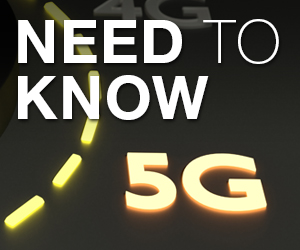Need to Know: 5G — Riding Wireless’s Next Wave
The race to build out “fiber in the sky” is on.
The next-generation mobile standard known as 5G, the fifth generation of the technology, is poised to create a new platform that is not just faster, but is much more agile than today’s state-of-the-art 4G (also known as Long Term Evolution, or LTE) networks.
Expected to debut wide in the next two years, it’s the latest in the continuum of every innovation in wireless technology, and it promises to disrupt — if not complement — many industries with lightning-fast communication speeds.
5G and Cable: Click here to find out what 5G means for the media industry.

5G will roll out as a network of cell sites offering Gigabit-level speeds (rivaling speeds offered via today’s wireline broadband) over the airwaves, with lower latency. (No more hourglass or beach ball icons!)
The technology will also underpin a vast array of fixed (non-mobile) and mobile devices, services and applications across an array of industries, including entertainment, education, music and medicine. Consumers need only a 5G-capable device to connect.
Deployments of 5G are already underway using pre-commercial technology by the usual suspects — the incumbent mobile network operators — but there are a host of new providers, including cable operators, who have become increasingly eager to add mobile and wireless to their service arsenals.
The first anticipated types of 5G-based services will be fixed wireless data offerings that can deliver speeds in the neighborhood of 1 Gigabit per second to the home or business. The implications for the Internet of Things, in a world where every home appliance and gadget is dependent on robust wireless connections, are enormous.
Blazing Fast Internet
For traditional services, imagine downloading a full two-hour movie, or an entire semester of classes to a student, in mere seconds — while also supporting the massive data rates that will be required by new virtual reality and augmented reality services.
Further out, 5G will also be mobile, with sub-millisecond latencies that greatly cut down the time it takes for data to be transferred after it is requested. That will be a major requirement, for instance, for mobile networks that can ensure that self-driving cars stay connected and can navigate the streets safely.
For now, despite its futuristic reputation of sensors everywhere, 5G is saddled with technical hurdles. For example, 5G signals, particularly when delivered in the upper, millimeter-wave frequency bands, will need a clear path, as their performance is vulnerable to obstacles such as trees and buildings.
For the cable industry, 5G is viewed as a threat and an opportunity. While 5G could create a new speedy broadband rival, it will also require the deployment of millions of dense, high-capacity small cells that are in stark contrast to the macro-cell networks used by today’s 4G services. And it so happens that cable’s fiber-rich network is well positioned to provide those critical backhaul and powering requirements. That could be a major moneymaker for the cable guys.
Not-Ready-for-Primetime Player

When will all of the pieces fall into place? Though some 5G-based fixed wireless services will take hold in 2018, the big ramp for the technology isn’t expected to emerge until 2020.
Several mobile service providers, cable operators and startups such as Starry are already well downstream with 5G-based fixed wireless tests and deployments. The mobile aspects of 5G aren’t expected to take hold in a big way until 2020.
In the meantime, initial 5G-based fixed wireless deployments could put some pressure on wireline ISPs.
“The use case [for 5G] I get most excited about is the opportunity to have a nearly nationwide broadband footprint,” Randall Stephenson, AT&T’s chairman, president and CEO, said on the company’s fourth-quarter earnings call, expressing confidence that 5G could serve as a fixed-line replacement for both business and residential customers.
“The capacity is there; the performance is there,” he said. “There’s going to be full Gigabit throughput.”
Mobile Making a Move
But that work isn’t stopping progress on mobilized 5G even before there are smartphones and other mobile devices that will support it. AT&T, for example, plans to launch a mobile form of 5G by the end of 2018 in about a dozen markets. However, the initial deployment won’t involve direct integration with laptops, smartphones or tablets, but instead rely on a smaller router-like device that can connect other devices to the 5G network.
“Think of this as a puck,” Stephenson said of the new device. He wants AT&T to push mobile 5G forward before handsets that support the next-generation wireless technology become available.
T-Mobile will be keying its 5G strategy on spectrum in the lower spectrum bands. While that will address the mobile opportunity, “it will also open up this massive set of opportunities on 5G in the Internet of Things space, where you can connect everything that can be connected,” Neville Ray, T-Mobile’s chief technology officer and executive vice president, said on the company’s Q4 2017 earnings call in February.
And the phone company plans to be aggressive. John Legere, T-Mobile’s CEO, said that 5G, when fully deployed, “will be in every spectrum band, and we will be participating in a lot of ways either through acquisition of spectrum, acquisition of companies, mergers and consolidation.”
But T-Mobile’s focus on the wide-area benefits of the 600 MHz band for its 5G rollout underscores a critical factor in that deployment: Not all spectrum is created equal. Millimeter wave signals don’t propagate well over long distances, have difficulty in the presence of trees and buildings and require an almost perfect line of sight.
“They hardly like air,” Robert Howald, Comcast’s vice president of network architecture, said at an industry event last year. He was making a joke, but he also made an important point — it’s unlikely that any 5G strategy will be able to live successfully on millimeter wave spectrum alone.
There is much to be worked out, but 5G is poised to be a game-changer for anything that is connected, streamed or downloaded.
Need to Know More?
Have a burning question about 5G — or maybe request for a different topic you’d like to see us tackle? Email us at needtoknow@nbmedia.com and we’ll put our top minds on it!
5G and Cable:Click here to find out what 5G means for the cable industry
More From NewBay on 5g:
- 5G and Television [TV Technology]
- 5G and Retail [TWICE]
- 5G and Video Production [Creative Planet Network]
- 5G and Radio [Radio World]
- 5G and ProAV [AVNetwork.com]
- 5G as a Platform [Sound & Video Contractor]
- 5G and Residential Integration [Residential Systems]
- 5G and Pro Audio [Pro Sound News]
- 5G and Education [Tech & Learning]
Multichannel Newsletter
The smarter way to stay on top of the multichannel video marketplace. Sign up below.
